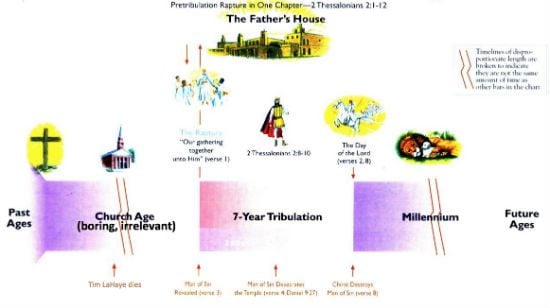Left Behind, pp. 421
After the Steeles meet with the Rev. Bruce Barnes, it’s Buck Williams’ turn:
Two hours after the Steeles had left, Buck Williams parked his rental car in front of New Hope Village Church in Mount Prospect, Illinois.
The real Mount Prospect is home to more than a dozen churches. I can’t help but wonder if they also exist in the fictional world of Left Behind and, if so, what’s going on at their buildings while Bruce stays up late at New Hope trying to design a cool logo for the Tribulation Force.
Were the parishioners or members or attendees of those other churches — the Baptists, Lutherans, Methodists, Episcopalians and Catholics — among the disappeared? If so, have they also, like New Hope, begun to gather small cadres of those who realize what happened and what they missed?
The gist of LB thus far suggests that all of those mainline Protestants and Catholics would not make the cut come Rapture time. They might call themselves Christians, but they’re not Real True Christians according to Tim LaHaye’s idea of God’s standards (which is to say, Tim LaHaye’s standards — he seems to think that on the day of judgment God will hire him as a consultant to separate the wheat from the tares). But even so, non-RTCs still have children. Or had children. The disintegration of every single child of every single family at all of those churches would lead to crowded sanctuaries filled with grieving, traumatized parents seeking answers.
Pastors like the now-departed Vernon Billings tend to stick to themselves. They don’t associate or cooperate much with other clergy in their communities. They don’t get involved with ministerial councils or interdenominational efforts. The stated reason for this is usually that light should have no fellowship with darkness, by which they mean that they would consider it a sin to associate with people like that liberal Methodist pastor who got arrested at that protest last year, or that woman from the Episcopal church who calls herself a priest, or that “welcoming and affirming” [epithet] from the local UCC church who wears a rainbow prayer stole.
Plus when the rabbi shows up at those interfaith meetings, they ask you not to mention Jesus when you pray, and you know the spell doesn’t work if you don’t say “in Jesus name.”
Working with other churches is perilously ecumenical. Ecumenism — cooperation among disparate Christian churches in recognition of our underlying unity — is not considered a Good Thing by people like Billings, or Lahaye and Jenkins. Even the most harmless-seeming forms of cooperation, such as taking turns providing shelter through a local interfaith hospitality network or some such, are too dangerous. It’s a slippery slope from there to syncretism, the collapse of absolute standards, moral relativism, one world religion, One World Government, human sacrifice, dogs and cats living together … mass hysteria.
The Ghostbusters quote at the end there is hyperbole. The rest of that isn’t. This is exactly what they believe. What they will tell you they believe. What they teach. Left Behind teaches this explicitly. Readers are intended to see the slippery slope between a metropolitan ministerial council and Carpathia’s “Enigma Babylon One World Faith.” This is meant as a warning.
This objection to interdenominational and interfaith cooperation was much-discussed in evangelical circles following 9/11. The scale and impact of that tragedy was such that a few RTC pastors for once set aside that objection, participating in some of the various memorial vigils and prayer services. That participation was a source of “controversy” and recrimination for months afterward. (That same kind of controversy never seems to follow, however, when the interfaith activity in question is a vigil for Terri Schiavo or an anti-abortion rally. That’s interesting.)
The willingness to interact or associate with clergy from other denominations or faiths used to be one of the markers for differentiating between fundamentalists and evangelicals. Evangelicals rallied behind Billy Graham as he effectively worked with local churches from every denomination (even papists!) to help coordinate his mass-evangelism “crusades.” Graham’s mega-church heirs — people like Bill Hybels and Rick Warren — have taken a similar approach. I may not like everything Warren says, but I appreciate that he’s willing to work with clergy of other denominations and even other faiths. This new generation of leaders, like Graham, insist that such cooperation is possible without compromising one’s own identity. Their critics disagree, vehemently. And those critics are no longer found only in the fundamentalist/separatist wings of the subculture.
The fundies’ white-knuckled anxiety — their barely repressed doubts and their fear that their faith may be a house of cards that would crumble if exposed to the wider world — seems to be spreading to other branches of the evangelical movement. That’s the predictable result of adding weird mythologies to one’s faith. The fundies convinced themselves that if the world is any older than 10,000 years then Jesus doesn’t love them. Thus they have to avoid all exposure to science. Evangelicals are trying to convince themselves that homosexuality is a choice and that the invasion of Iraq was God’s Will. Like the fundies, they have welded these ideas to the bearing walls of their faith, so that if they are not true, then nothing is true. They thus find themselves, like the fundies, having to avoid exposure to an awful lot of the real world around them.
There’s one other reason that I think people like the Rev. Billings oppose interdenominational cooperation. It has to do with power and influence. Evangelical polity — the structure of this unstructured, nondenominational movement — is roughly feudal, like a collection of competing fiefdoms. It’s very important to a guy like the Rev. Vernon Billings that he be the biggest fish in the pond. Acknowledging that his is not the only pond, and that it is far from the largest, threatens his sense of authority. Once you recognize the legitimacy, or even the existence, of all those other churches in town then it’s much harder to maintain the illusion that you’re the Pope of Mount Prospect.
Getting back to those other churches in town, if we accept the world of Left Behind as the authors have sketched it out for us, then we have to assume that most of the adults from those other congregations were not RTCs and so were not among the disappeared. Bruce Barnes was until very recently a faux-Christian himself, but he seems to view the clergy and laity of these other churches as an even more reprobate species of fraud. It thus never occurs to him to speak to them about what he knows or to attempt to recruit them to his cause.
But while it’s not surprising that he doesn’t reach out to them, it’s strange that none of them are reaching out too him. Those other clergy may not believe the premillennial dispensationalist heresies that Billings taught, but they would all be familiar enough with the substance of them to recognize what they were seeing. They would realize by now what was happening — realize that they, like all the church fathers and theologians they had ever studied, were wrong and that Billings and Hal Lindsay and (especially) Cassandra LaHaye were right. And despite their being overwhelmed with their duties chaplaining the traumatized community, those other clergy would all be getting in touch with Bruce Barnes.
That doesn’t happen here. It doesn’t happen for the same reason that Bruce has no problem renting a car or driving 20 miles out I-90 to Mount Prospect despite all the chaos and debris that should be but isn’t affecting anyone, anywhere in this book a mere 10 days after The Event.
And but so anyway, Buck pulls up to the church:
He had a sense of destiny tinged with fear. Who would this Bruce Barnes be? What would he look like? And would be be able to detect a non-Christian at a glance?
The authors apparently imagine that his is a common question unbelievers have about RTC clergy: Does their non-Christian detection power work at a single glance, or does it require physical contact?
I can’t figure out why anyone would ever think this. Nor can I figure out why the authors would think that anyone would ever think this. It’s not just wrong, it’s bewilderingly wrong.
And anyway why should Buck care? He’s not trying to pass himself off as a Christian, so he shouldn’t be worrying that Bruce’s spiritual gaydar will penetrate his cunning disguise.
Buck sat in the car, his head in his hands. He was too analytical, he knew, to make a rash decision. Even his leaving home years before to pursue an education and become a journalist had been plotted for years. To his family it came like a thunderbolt, but to young Cameron Williams it was a logical next step, a part of his long-range plan.
What family wouldn’t be thunderstruck? Buck finishes high school and then astonishes them all by announcing that he’s going away to college to pursue a career. It’s so utterly unprecedented.
We’re constantly being told that Buck is methodical and analytical (always a bad trait in LB), but we never see this. It seems that by “analytical” in this case the authors mean his stubborn refusal to accept the undeniable implications of explicit divine intervention. That actually seems like the opposite of analytical.
We’ve also seen that not only is Buck capable of making a “rash decision,” he has a propensity for it. He flew to England to expose an international conspiracy, but less than 24 hours later he was cutting a deal with them and helping them to cover their tracks. He met Chloe yesterday, fell in love at first sight and impulsively booked the seat next to her on a flight to Chicago.
Again, this could have worked in a different novel where this was an intentional device — the self-deceived voice of an unreliable narrator rather than the voice of one writer’s Mary Sue substitute. But here the chasm between Buck’s concept of himself and his actual character and behavior escape not just his notice, but the authors’ as well. They don’t perceive any such gap, and even if they did they seem to think that their assertions trump the actions they describe. We’ve never seen Buck think “analytically” and we have seen him, time and again, make rash decisions, but when the authors contradict this — “He was too analytical … to make a rash decision” — that’s supposed to settle the matter.
This is Bad Writing, but it’s not wholly unrelated to the authors’ Bad Theology. The same gap between what they tell and what they show, between asserted character and actual character, can be seen wherever the novel touches on the nature of God. They tell us that the God they believe in is good, just and loving. But the God they show us is a bloodthirsty, capricious, evil monstrosity.
That’s partly the result of Bad Writing, too, but more than that it seems to be Bad Writing by Bad People. The character of God in LB is, like Buck and Rayford, another Mary-Sue wish-fulfillment surrogate for the authors. They have recreated God in their own image. And that image isn’t pretty.












